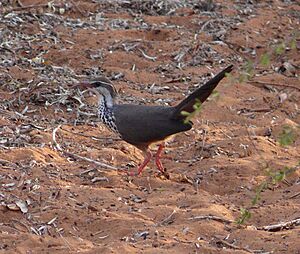Subdesert mesite facts for kids
Quick facts for kids Subdesert mesite |
|
|---|---|
 |
|
| male | |
| Conservation status | |
| Scientific classification |
The subdesert mesite (Monias benschi) is a special kind of bird that lives only on the island of Madagascar. It spends most of its time on the ground. This bird is one of three species in the mesite family, called Mesitornithidae. You can only find it in a small, low-lying area in southwest Madagascar.
Contents
What Does the Subdesert Mesite Look Like?
The subdesert mesite is a medium-sized bird that lives on land. People often say it looks a bit like a rail bird. It has a long beak that curves downwards, which helps tell it apart from other mesites.
Both male and female subdesert mesites have greyish feathers on their backs. They also have thin white lines above their eyes, like eyebrows! Their bellies are white.
How to Tell Males and Females Apart
- Males: Have black, crescent-shaped spots on the sides of their neck and upper chest.
- Females: Have reddish-brown spots. These spots might blend together to look more generally reddish-brown. Females also have a tan patch on their cheeks.
Where Do Subdesert Mesites Live?
The subdesert mesite lives only in a specific type of forest called "spiny thicket." This habitat has open areas and is found from sea-level up to about 425 feet (130 meters) high.
They live along a coastal strip in southwest Madagascar. This strip is about 125 miles (200 km) long and 19 to 37 miles (30 to 60 km) wide. North of a place called Manombo, there's still a good amount of suitable habitat, about 965 square miles (2,500 km²). In other areas, their home is breaking up into smaller pieces.
How Do Subdesert Mesites Live?
Subdesert mesites find their food by picking up small creatures without backbones, seeds, and fruits from the ground. They might even dig a little into the soil to find tasty snacks.
Nests and Young
These birds build their nests on platforms made of twigs. They place these nests in bushes, usually within 6.5 feet (2 meters) of the ground. A female mesite usually lays one or two eggs. Both the male and female birds help to incubate the eggs (keep them warm) and take care of the young chicks. Sometimes, one female might mate with several males (this is called polyandry). Other times, one male might mate with several females (this is called polygyny).
Subdesert mesites live in groups. If something disturbs them, they make a loud "nak! nak!" sound to warn each other.
Why Are Subdesert Mesites Vulnerable?
Even though there might be many subdesert mesites in their small home, their population is decreasing. They are considered "vulnerable," which means they could be in danger of disappearing.
Threats to Their Home
Their habitat is being damaged by several things:
- Slash-and-burn farming: People clear land for growing maize (corn) by cutting down trees and burning them.
- Making charcoal: Trees are cut down to make charcoal for fuel.
- Logging: Trees are cut down for wood to sell or to use for building.
These activities are happening in most of the areas where the subdesert mesite lives, except for the region north of Manombo.
Other Dangers
Besides habitat loss, subdesert mesites also face other dangers:
- Dogs: Dogs can hunt and catch the birds.
- Hunting: People sometimes hunt them.
- Rats: Introduced rats (Rattus species) might also be a problem for the birds or their eggs.
In 2002, experts estimated there were about 115,000 subdesert mesites. However, their numbers are believed to be falling. Because of these threats, the International Union for Conservation of Nature (IUCN) has listed the subdesert mesite as a "vulnerable" species.


